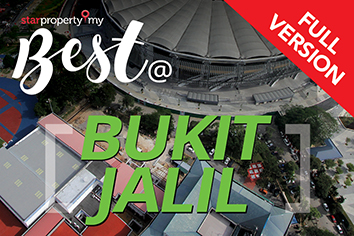Bukit Jalil under the microscope
03 Sep 2018
>> TRANSACTION By Lee Yan Li & Ng Pau Ling A ccording to the World Bank Group’s 2015 report titled “East Asia’s Changing Urban Landscape: Measuring a Decade of Spatial Growth,” Malaysia is among the more urbanised countries of East Asia.
The overall urban area of Kuala Lumpur grew from about four million inhabitants in 2000 to 5.8 million in 2010, reaching a relatively high average annual growth rate of 3.8%, placing the city’s urban area on the list as the eighth largest in the region as of 2010.
It surpassed some mega cities like Jakarta, Manila, and Seoul despite its smaller population.
Urbanisation has created an opportunity for suburbs within the Klang Valley, and the growth of population in the capital city will eventually create a spillover effect on the surrounding neighbourhoods. The business establishments and educational institutions have also increased the student population and working professionals of the area. Chinese make up the majority of the population in Bukit Jalil, followed by Indians, Malays and other races.
It is increasingly becoming a sought-after address for the middle-class and young working professionals, and this situation has encouraged many developers to come into the region.
Thus, the locality has enjoyed rapid development over the past few years. Landed properties such as in Jalil Sutera, Sri Jalil and Taman Esplanad are in limited supply and mostly owner-occupied, which has resulted in less transactional activities in this market segment. “A decade ago, the 2.5-storey terraced houses in Jalil Sutera were launched at RM200 per sq ft or RM500,000.
Those properties now command a price of up to RM1.8mil,” said Reapfield Properties (Bukit Jalil) Sdn Bhd senior real estate negotiator Prabu Jai Balan.
In 2010, the sub-sale price of Vista Komanwel was around RM220,000 to RM250,000.
Now, the asking price ranges from RM400,000 to RM580,000.
Prabu Jai Balan According to Prabu, the market price for Vista Komanwel is about RM400,000 while the rental rate can be as high as RM3,000 even though it is one of the oldest developments in Bukit Jalil.
The transaction for this project is still hot, mainly due to the high demand in the rental market.
The launch of the 50-acre Bukit Jalil City project (developed over three phases), with an estimated GDV of RM4bil, will be one of the highest priced residential offerings in the area.
Paul Khong Savills Malaysia managing director Datuk Paul Khong said the top-end residential condos like The Park 2@Pavilion Bukit Jalil and The SkyLuxe On The Park can fetch around RM850 to RM900 per sq ft, while the new standalone residential projects in the mid-tier category like The Rainz, The Andes and Parkhill Residence are going for about RM500 to RM700 per sq ft.
“The compounded annual growth rate (CAGR) for residential strata properties here in Bukit Jalil have recorded about a 10% per annum growth over a 10-year period (2008 to 2017),” he said.
Khong said the high-rise strata properties are generally the most popular when considering affordability and location.
While landed products are always the preferred choice, the price tag easily exceeds RM1mil per unit and supply is limited.
The influx of developers into the region has raised concern among some residents who believe that Bukit Jalil may see an oversupply. “The landed segment is becoming a bit too pricey due to limited supply and high land prices.
Therefore most of the newer stocks are strata properties that target the young and middle working class,” said Khong.
Vicky How Propedia Consultancy founder Sr Vicky How raised the concern of an oversupply in the area, with an upcoming offer of 11,214 units of residential properties in the region from 2018 to 2022.
She said that the current total residential supply in Bukit Jalil, Sri Petaling and Kuala Lumpur city centre is 103,805 units.
“The sudden spike in supply from 2015 to 2017 has jeopardised the residential property market in Bukit Jalil, which has been either stagnant or falling in price although some developments enjoyed minor capital appreciation,” said How, adding that the situation of oversupply may result in price stagnation and traffic congestion in the near future.
However, given Bukit Jalil’s accessibility, connectivity and convenience, Khong feels that the neighbourhood ranks quite well in its overall competitiveness when compared to other areas.
He said the neighbourhood is maturing well, while property prices are flat due to general market conditions.
Khong added that the change of government had created a feel-good factor, and with the zero-rated GST on commercial properties it could be the right time to look for a bargain in the market.
“The completion of Pavilion Bukit Jalil in 2020 will turn this neighbourhood into the new commercial hub of Kuala Lumpur South,” he said.
According to Khong, many buyers are keeping an eye on the Pavilion project and the surrounding residential properties from the aspects of lifestyle, convenience, accessibility and location.
Said Prabu: “These one or two years will be the best time to buy property in Bukit Jalil.
Think Puchong before IOI Mall.
Think Seputeh before Mid Valley Mall.
What is the price then and now? I foresee that there will be a price hike when Pavilion Bukit Jalil is completed in 2020.” How many LRT stations are there in Bukit Jalil? Join our contest at bit.ly/ExploreBukitJalil to win a calendar potted plant! >> BACK TO MAIN PAGE.

